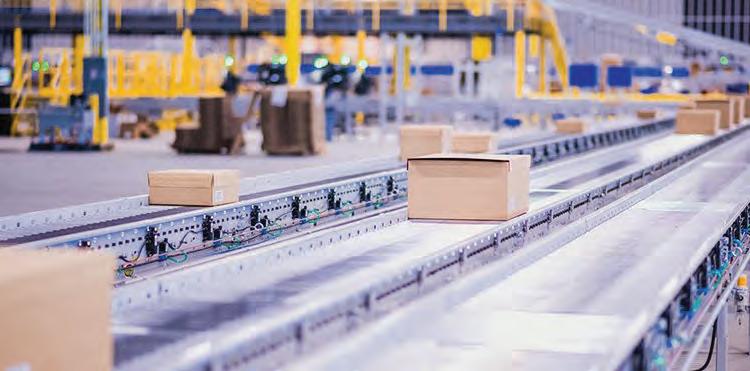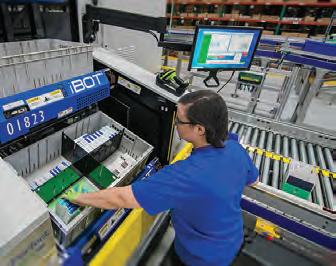Integrated success
Matt Weller brings system thinking to supply chain
Air & Ocean freight

Indigenous procurement

Nearshoring
The 2025 Chevrolet Equinox Supply chain volatility





Matt Weller brings system thinking to supply chain
Air & Ocean freight

Indigenous procurement

Nearshoring
The 2025 Chevrolet Equinox Supply chain volatility




Successful intralogistics is all about building smart and staying agile throughout every stage of facilities management. With our engagement model that helps you ideate, activate and adapt innovative solutions, combined with the power of our family of companies, we can help you optimize your facilities for whatever tomorrow brings. Tackle the challenges of today and make the most of the opportunities of tomorrow.
ONE TRUSTED PARTNER THREE STAGES OF OPTIMIZATION ENDLESS OPERATIONAL ADVANTAGE





The trade war with President Donald Trump’s US administration and the bellicose threats against Canada’s sovereignty (51st state!) have unified us in ways that may have seemed far-fetched just a few months ago.
The 2025 4 Nations Face-Off hockey championship game between Canada and the US in February felt somehow existential to some in its importance.
The sale of Canadian flags has surged, as has overall pride in the country and what it means to be Canadian. In fact, Leger Marketing did a survey in March showing that pride in being Canadian has jumped from 80 to 86 per cent – a trend that has transcended most regions and demographics.
Even the long-disputed topic of internal trade barriers – the mesh of government-imposed laws, regulations, standards, and other hurdles stanching the country’s flow of goods, people, and services – has come up for review. And it’s not the first kick at this can we’ve taken. There’s a decades-long history of trying to make trade freer across Canada.
The 1995 Agreement on Internal Trade (AIT), for example, looked to reduce trade barriers, although left many of them intact, even after its review in 2009.
The New Ontario-Quebec Agreement saw some progress in removing barriers, especially in construction and procurement. After that, the Canadian Free Trade Agreement (CFTA) launched in 2017 reduced barriers in procurement, services, investment, and labour mobility.
Yet despite these efforts, several barriers have remained. Now however, Trump’s tariffs appear to be speeding up the process even more.
Canada’s new Prime Minister, Mark Carney, mentioned soon after his inauguration that creating a unified economy from 13 separate economies will be one of the main focuses of his incoming government.
This is a good thing for the Canadian economy, employment, and productivity. A 2019 IMF working paper claims that barrier removal could see our GDP jump by as much as seven per cent, or gains of $130 billion.
Fewer barriers would make life easier for businesses, as they would have unfettered access to a larger domestic market. They would be able to compete more readily, allowing them to expand nationally with greater ease.
Our supply chains could also become more resilient. Goods, services, and labour could travel across Canada unimpeded, which would help to protect them against disruptions.
In the face of labour shortages, allowing for free travel of labour between provinces and territories helps workers fill skills gaps anywhere. Finally, removing trade barriers makes for a stronger Canadian economy and overall improved national prosperity. A more integrated economy attracts more investment by increasing our global competitiveness.
I could go on, but hopefully these selected advantages highlight how beneficial knocking them down could prove. I’m hoping that the trend towards greater liberalization in doing business in Canada, along with a more unified business landscape, will continue.

EDITOR
MICHAEL POWER 416-441-2085 x7 michael@supplypro.ca
PUBLISHER
FARIA AHMED 416-441-2085 x 5 faria@supplypro.ca
DESIGN
Art Direction ROY GAIOT Design Consultation BLVD AGENCY
iQ BUSINESS MEDIA INC.
Vice President
STEVE WILSON 416-441-2085 x3 swilson@iqbusinessmedia.com
President & Executive Publisher ALEX PAPANOU
PUBLICATION MAIL AGREEMENT NO. 43096012 ISSN 1497-1569 (print); 1929-6479 (digital)
CIRCULATION
Mail: 126 Old Sheppard Ave, Toronto ON M2J 3L9
SUBSCRIPTION RATES
Published six times per year
Canada: 1 Year $ 99.95 CDN
Outside Canada: 1 Year $ 172.95 USD Single price per copy $18.00 CDN
Opinions expressed in this magazine are not necessarily those of the editor or the publisher. No liability is assumed for errors or omissions. All advertising is subject to the publisher’s approval. Such approval does not imply any endorsement of the products or services advertised.
Publisher reserves the right to refuse advertising that does not meet the standards of the publication.
No part of the editorial content of this publication may be reprinted without the publisher’s written permission. © 2021 iQ Business Media Inc. All rights reserved. Printed in Canada.
Supply Professional is the Official Magazine for NISCL


I am submitting this column in early March. I specify the date because I’m going to be writing about Donald Trump’s tariff policy, which changes in any number of directions in a single day. Today, Mark Carney replaced Justin Trudeau as Canada’s prime minister. His father, Pierre Trudeau, made the following statement to an American audience in 1971: “Living next to you is in some ways like sleeping with an elephant. No matter how friendly and even-tempered is the beast, if I can call it that, one is affected by every twitch and grunt.”
On March 4, 25 per cent tariffs were imposed on Canada and Mexico on a variety of products. At the time of writing, several of the most important ones for Canada – including duties on auto parts – have been delayed until April. I’ll say this one last time: they might have already been applied, could be applied later than April, waived entirely, or all of the above. That goes with the territory when you’re trading with the elephant.
It would help if a bit of context to the trade relationship between our countries was provided. Even before Canada’s founding, there was debate between those who favoured managed trade and those that thought free trade was the better path. In 1965, the Auto Pact was signed between the two countries, a historic managed trade relationship. It allowed each country to specialize in different vehicles. But at the end of the day the formula was simple. If Canada represented 10 per cent of the North American automotive market, it would produce 10 per cent of the
value. The key principle was balance with neither party experiencing a trade surplus.
Fast forward to 1987. In October of that year, the two countries signed a free trade agreement that went into effect January 1, 1989. It eliminated tariffs, reduced non-tariff barriers, and included a dispute settlement mechanism. The deal was expanded to include Mexico. The Canada-US Free Trade agreement morphed into the North American Free Trade Agreement (NAFTA). There were fears from some that these deals would doom us. However, as it turns out, these treaties have worked quite well for Canada. But the current US president thinks maybe too well.
Many of you have a visceral hatred of Donald Trump. But if we want to figure out how to make our trade relationship work for the next three years, it’s useful to “steelman” his argument to understand why he thinks his country is getting the short end of the bartering stick. In 2022, Canada recorded a trade surplus of approximately US$80 billion. That dropped to US$68 billion in 2023. Last year, it came in at US$45 billion – so at least the trend lines (at least from Trump’s perspective) are moving in the right direction.
Donald Trump sees the world in a particular way. There are winners and there are losers. When a country runs a trade deficit, it loses. He doesn’t like to lose. This explains his tariff policy. Now that we understand where he’s coming from, what can we do to serve our best interests? Here’s my idea. It’s time to abandon free trade and return to the spirit of the
Auto Pact and a “managed trade” relationship. Because whether we like it or not, the US will be our largest trade partner for the foreseeable future.
Here’s how this could work. We approach Trump with the following proposition: suspend tariffs between our two countries and then harmonize trade policies with like-minded trade policies. You want to place tariffs against China? We’re with you. Then after those tariffs are imposed, we commit to import less from China and more from the US. In fact, we’ll commit to make automobiles built by those with unfair trading practices prohibitively expensive. Let’s construct a unified North American trading bloc.
This would mean working with countries with like-minded trade policies. I’ve heard Canadian politicians talk about seeking other trading partners. Our biggest export products are automotive and energy. Do you think that China and India would ever import Canadian-made cars or car parts? How about energy? Doesn’t it make more sense for the Europeans to import oil from Russia or the Middle East?
Whether we like it or not at times, we share a bed with what is now a rather ornery pachyderm. SP
“Even before Canada’s founding, there was debate between those who favoured managed trade and those that thought free trade was the better path.”

Everyone does it and some are very good at it. The “it,” is the art of negotiations. Don’t treat negotiations like a game. It’s critical you get it right. You should think beyond price as negotiations might not be about discounts. Instead, keep in mind tangibles like extended warranties, faster delivery, training, or other perks. They might be valuable to your organization and easier for the supplier to concede.
Most people are aware of BATNA which is the best alternative to a negotiated agreement. Yet there are some key components to add to your negotiation toolbox. Often, the side that has done the most preparation wins.
Preparation is the key, and it starts early. I ensure that when I start working with a supplier, I share what the future looks like regarding my organization’s expected growth. I use realistic numbers and show our progressive trend. This helps realize potential savings as they can now see you becoming a key account. This also helps them identify your distinct value.
Show that you understand the supplier’s business, costs, structure, and challenges. Knowing that the sales representative will get a bonus if they finalize your contract before a certain date. This allows you to use time to your advantage. It’s OK to ask for help from those that have experiences you lack. Negotiations can be complex, and professional assistance may make a difference.
Allow others to negotiate on your behalf, then review to ensure that leveraging this type of contract
is a good fit for your organization. An example is to take advantage of the work done by group purchasing organizations. I would review their processes, compare their pricing and terms with what I have, then decide whether to proceed with their agreement.
It’s important that you have a way to remember key components that will make up your methods and style. Use this acronym to remember how to prepare for negotiations: “I foresaw it.” This stands for “interests, facts, options, rapport, empathy, and ethics, setting and scheduling, alternatives, who, independent criteria and targets (goals and ranges).” These are important to be a successful negotiator.
Some wait for the other side to show their hand. Some start either high or low to get them focused on a number. Always start with the number or terms that work best for you. Don’t be ridiculous, for instance, by offering $10 when the item is normally $100. Be fair and understand that your supplier must make a profit to stay in business. Some will provide you with what you asked for and do what they can to add costs later. In construction, add-ons or items not included in the initial contract are where a lot of contractors make their profit.
The following bullet points will help during negotiations: Delay: don’t negotiate if you aren’t ready. Collaborate: working with the supplier, not against them, gives better results.
Manipulate: it’s alright to do this with the situation but not the person. People have long memories Power: the one who needs the agreement less has more power. Create options that let you get what you need.
Pressure: what’s forcing either you or them to get the deal done? Position: where do you sit? I tend to be at the back of the room and either at the end of the table or to one of the sides at the back. This allows me to view everyone’s faces to gauge interest and expressions. The position can also be the location where you are meeting: your turf, theirs, or a neutral site. They all have their purpose. I like meeting at their location. I believe this is my power move. I am not intimidated by where they are, and they tend to be overconfident, which should be to my advantage.
Also, consider the 7-38-55 rule –you’re judged by what you say (seven per cent words), your voice and facial expressions (38 per cent) and most of all body language (55 per cent). Some people practice in front of a mirror or film themselves to see which traits or characteristics will weaken their position. Other strategies include talking less and listening more. The other side often hates the silence and offers valuable information. Have your numbers memorized, including various scenarios and contingencies. Use the power of the question. You could start with: “what would it take for you to lower the cost by 10 per cent?” This often leads to unexpected solutions.
“It’s OK to ask for help from those that have experiences you lack. Negotiations can be complex, and professional assistance may make a difference.”
Create leverage by knowing how important coming to an agreement is for the other party. Know your walk-away point and be prepared to do it. Sometimes there are no winners. Each side did not gain all that they wanted. Often, good enough is the best you can do. SP
Investment in software to optimize warehouse operations will expand through 2025. According to global technology intelligence firm ABI Research, warehouse management system (WMS) revenues will surpass US$5 billion by next year and US$10 billion by 2030.
Leading providers of supply chain software tools, including WMS, saw double-digit revenue growth through 2024, the firm said in its Smart Warehousing market data report. Companies have reported growth, largely attributed to Softwareas-a-Service (SaaS) and shifting to advanced cloud-native solutions. Ensuring data transfer and advanced picking processes is leading to more investment in private wireless networks in warehouses, like private 5G. ABI Research estimates the global market for private wireless networks in warehousing could hit US$6 billion by 2030.
BDO Canada has released Canada’s Productivity Paradox, a report outlining factors in the country’s lagging productivity. The report shows how businesses can enhance efficiency, innovate, and compete globally.
Canada’s productivity gap is evident in several areas. For example, it takes Canadian workers 1.4 times more effort than their US counterparts to add the same value. In 2021, Canada’s investment in information and communication technology (as a per cent of GDP) was 25 per cent, compared to 37 per cent in the US.
Among the report’s recommendations is increasing research and development (R&D) investments, embracing new technology and ensuring adoption, and leveraging partnerships with private equity, pension funds, government entities, and public companies.
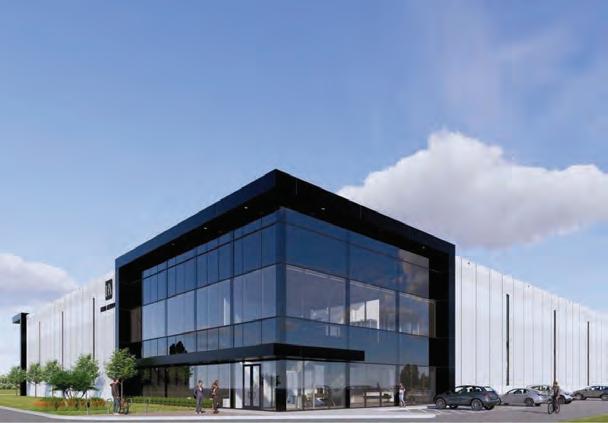
Sustainable packaging solutions company Eco Guardian will open a manufacturing facility in Ontario, set to be fully operational in Q4 2025. The facility will produce 100 per cent compostable and recyclable paper products. The large-scale manufacturing facility will feature a production capacity of two billion cups annually, advanced sustainability
DHL and the New York University Stern School of Business have released the DHL Trade Atlas 2025, providing analysis of global trade trends. The report covers nearly 200 countries and territories, highlighting how global trade growth has proven surprisingly resilient in the face of disruptions. This pattern is likely to continue even with US tariff increases. Forecasts predict goods trade will grow at a compound annual rate of 3.1 per cent from 2024 to 2029. This roughly aligns with GDP growth and represents modestly faster trade growth compared to the previous decade. Even if the US implements all of its proposed tariff increases and other countries retaliate, global trade is still expected to grow over the next five years – but slower.
Amid recent tariffs, Canadian businesses considering or already making changes to their supply chain must stay vigilant against increased fraud and cybersecurity risks, KPMG in Canada specialists warn.
A recent KPMG in Canada survey of Canadian businesses found that in anticipation of tariffs, nearly half (44 per cent) of respondents said they are already reconfiguring their supply chains to divert US-destined exports to these third-party countries, with another 44 per cent exploring that option.
But changing suppliers and reconfiguring supply chains can introduce numerous fraud risks.
production technology, and will use sustainable materials including FSCcertified paper, compostable linings, and bamboo paper.
Along with paper cups and bowls, the facility will have the capability to produce custom-designed food packaging solutions. This includes burger boxes, fry boxes, paper trays, and more.
KPMG’s forensic and cybersecurity specialists recommend Canadian organizations consider certain points when changing suppliers. Among those points are to conduct an integrity due diligence when switching suppliers; have legal experts review contracts to mitigate risks; and implementing strict controls and verification processes for invoices to lower the risk of payment fraud, among others.

BY CHRISTIAN SIVIÈRE
I generally don’t like the term “trade war,” as the word “war” is too extreme and we should not use it lightly. Today though, it seems adequate, as Trump’s wanting to use “economic force” against Canada and Mexico (and several other countries) follows the same principle as Putin using military force against Ukraine: different means but the same fundamentals.
Judging from the first weeks, the Trump administration is doing crazy stuff to coerce their trading partners, including allied countries, into making concessions to bring money into US coffers. The US is the most indebted country in the world, has a huge budget deficit, and Trump has cut taxes for corporations and for the wealthy. But where is the money supposed to come from? For the 47th president, it’s going to come from tariffs on foreign goods.
Trump’s tariffs (or the threat of) on Canada, Mexico, China, and many other countries, as well as the potential annexation of Canada, Greenland, Panama, and Gaza, have upended international trade in a big way, creating a lot of uncertainty. Likewise, the discarding of DEI initiatives, the relaxing
of financial rules, including on cryptos, AI and corruption, the closing down of USAID, leaving the Paris Accord on climate action or the World Health Organization, have transformed the US from a stable and reliable world leader, into a potential threat. This culminates with the Trump administration seemingly siding with the aggressor in the Russia-Ukraine war.
Any such threats to international trade can have a big impact on ocean freight and airfreight. Both transportation modes have enabled globalization and benefit from the free flow of goods around the globe. Both also suffered during the pandemic, though to different degrees: ocean carriers, operating in quasi cartels, simply laid up ships and resorted to
blank sailings to keep rates stable, then jacked rates up to 10 times the previous amount, making exorbitant profits, during the recovery. Air carriers had a more difficult time, as during the pandemic there were simply no passenger flights, hence no revenue, for some time. The post-pandemic recovery was relatively smooth for international transportation, until January 20, 2025.
In 2024, ocean freight demand increased by about seven per cent, while capacity was up three per cent. The industry has been facing extra costs due to the longer transit times resulting in having to go around the Cape of Good Hope on the way to and from Asia, and the North Atlantic via the Suez Canal and the Mediterranean. This is due to continuous Houthis rebel attacks on ships crossing the Red Sea, in support of Gaza. Last year’s volume growth was driven by Asia Pacific ports, with the ongoing US container trade imbalance caused by growing demand for consumer goods, in spite of the US tariffs on Chinese products.
In a way, this confirms that tariffs are not a panacea for trade imbalances. Meanwhile, the uncertainties created by Trump’s trade wars have put a damper on growth, driving down ocean freight rates on the main east-west lanes. In early March, the Drewry WCI composite index was 76 per cent below the previous pandemic peak of US$10,377/TEU in September 2021 and the lowest since January 2024. The index is still 79 per cent higher than the average pre-pandemic level of US$1420/TEU in 2019.
A new element has created another challenge for the ocean freight industry: Trump wants to revitalize the US shipbuilding industry. This could bring about massive, increased costs on ocean operators and a new round of supply chain chaos. In order to finance this, the Trump administration wants to impose hefty fees, not just on Chinese-owned vessels but also on Chinese-built vessels calling at US ports. China has been so dominant in shipbuilding activities that this levy could hit virtually every ship calling at US ports. According to the World Shipping Council, this could add up to
US$30 billion of annual costs on American consumers and double the cost of shipping US exports, demonstrating how Trump’s sometimes reckless policies result in consequences that run counter to his stated goals.
Moving to better news, the port of Vancouver has reported record volumes of Canadian trade in 2024, with statistics showing a record 158 million metric tons of cargo moved through the port last year, a five per cent increase over 2023, led by strong performances in the auto, bulk, and container sectors. About 80 per cent of the international volume it handled was Canadian trade with countries other than the US. Challenges the port faces included the impact of climate change and extreme weather such as wildfires, increasing geopolitical tensions, and labour issues. When it comes to air transportation, global passenger demand
“The uncertainties created by Trump’s trade wars have put a damper on growth, driving down ocean freight rates on the main east-west lanes.”
reached a record high in 2024, according to figures produced by IATA, the International Air Transport Association. Total passenger traffic measured in revenue-passenger-kilometres (RPKs) rose 10.4 per cent compared to 2023, standing 3.8 per cent above pre-pandemic (2019) levels. International demand increased 13.6 per cent, while domestic demand was up 5.7 per cent. Global air cargo demand, measured in cargo-tonne-kilometres (CTKs) increased 11.3 per cent in
2024, exceeding the record volumes set in 2021. This means airlines are doing well, generally speaking, and certainly much better financially than a couple of years ago.
So far this year, global airfreight volumes and rates have been rising gently. But there is a lot of confusion over changing US rules affecting e-commerce (e-commerce is the main growth driver for airfreight). The US have a very high duty-free allowance of U$800/day, applying both to consumers and businesses, enabling the importation of goods from anywhere in the world, free of duties but also free of scrutiny (counterfeit, health, forced labour, and so on).
In customs language, this provision is called Section 321. As part of its trade war against China, the Trump administration wanted to prevent Chinese products from benefitting from this provision, but this turns out to be complex, in view of the huge volume of parcels coming in on a daily basis. So, this provision

has been re-instated for Chinese products, but we don’t know for how long. It’s also possible that the US will decide to target Canadian products and disallow them from this section 321 exemption. This would be a blow for Canadian businesses selling online to US customers, a lucrative activity for many companies, Canada being the second source country for e-commerce goods into the US, after China. SP
25_001645_Supply_Professional_APR_CN Mod: March 3, 2025 9:04 AM Print: 03/10/25 page
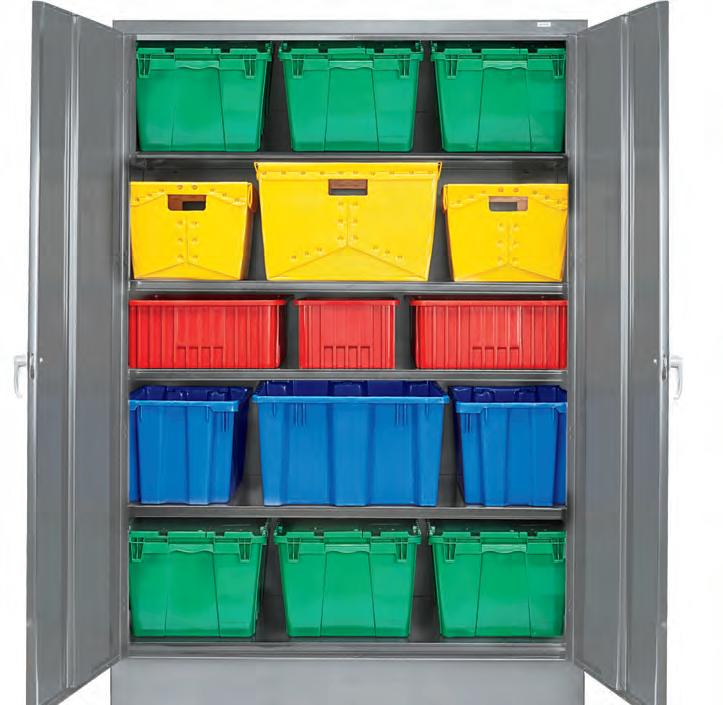
BY MICHAEL POWER
Matt Weller was the kind of kid who would take apart his toys, then try to put them together again, just to see how they worked. He’s always been interested in the inner workings of things, Weller says of himself, and not just toys. The Kitchener, Ontario resident and long-time supply chain practioner has always looked to find out why things are a certain way.
“Why was it made in the way that it was made? Why was something a certain shape? What might have been the decisions that start you thinking about manufacturing and how things are produced?” says Weller, who is the founder of Naviga Supply Chain, an advisory firm formerly called Berlin KraftWorks Inc. “And you might think that’s a very strange way for a kid to think, and you’re probably right, but nonetheless, that is how I thought.”
When he got older, Weller continued his interest in how parts of the world influenced and interacted with each other, whether within the economy or other areas. “If you’re someone
like me, you start to think about how you could get from the world you’re in now to the world that is tomorrow.”
Weller’s approach to the world, how it works, and the problems and solutions it presents may be somewhat unique. He is also unique because, unlike many, he didn’t enter supply chain after spending time in another area, like finance or operations. He realized early that supply chain was the career path he wanted to follow.
Weller grew up in Peterborough, Ontario. The area once boasted a lot of manufacturing that eventually moved to other areas. Watching that employment base disappear encouraged him to pay even more attention to how parts of the world fit together. And as a career, supply chain aligned with his view, Weller notes.
“Supply chain is the only field of study that’s concerned with the relationships between the moving pieces of a business,” Weller says. “Everything else tends to focus on specific items within a business. You have accounting, engineer-
ing, you’ve got different elements of supply chain – sourcing, or procurement, or strategic sourcing. But each one of them sort of has a siloed focus, a piece of the system. Supply chain as a system has to consider all of it and is less concerned with the individual pieces and more concerned with how the individual pieces work together or don’t work together, as the case may be.”
Weller completed two three-year programs concurrently, both in business administration. He attended Peterborough’s Fleming College. At the time, the school used the term materials management and distribution, rather than supply chain, to describe the focus of one of the subjects that Weller chose to study. The other course was in industrial waste management and industry, which focused on environmental law and regulation for industrial applications, with some environmental science thrown in.
“There was no university path if you wanted a career in supply chain,” Weller says. “I did that while working full time and got them both done in three years.”
After studying from 1997 to 2000, Weller moved to Guelph to start his supply chain career. His first job title in the field was MRP controller, with responsibility for everything related to demand management. The company produced equipment for the plastic injection molding industry. The job let Weller see how various pieces of the manufacturing system functioned, including sales, managing demand and production, and measuring shipments. All those parts had to work together, with Weller focusing on the demand piece.
Around this time, Weller also got involved in the local chapter of a supply chain organization called APICS, which has since rebranded as the Association for Supply Chain Management (ASCM). Before long, he became president of the chapter, exposing him to manufacturing companies of different sizes and with different focuses.
“It just kind of supercharged my understanding of everything and gave me a lot of insight beyond my own direct job at the time,” he says. By 2004, Weller had switched to both a new company and focus. The Cambridge, Ontario-based organization made industrial shredders, and he was now working in purchasing. While not convinced it was an area he wanted to remain in, he enjoyed the experience. He also decided that he wanted to spend time in every major subset of supply chain to fully understand them. This led him to work in inventory management, purchasing, and, eventually, supply strategy and logistics.
“I started to understand the merits of lean manufacturing as not a set of tools,” Weller says.

“I’d understood them as a set of tools up to that point but started to understand it as an integrated system, as a way of thinking about manufacturing. Years later, I would come to know that as system thinking. But at the time I was getting firsthand experience about how things needed to integrate and what would happen when they weren’t well integrated. For any company, you have successes and failures, and you could see that supply chain exposes you to that. They don’t have to be your failures. They could be somebody else’s in the chain, but you’re still exposed to it.”
Another job switch came in 2010, when Weller became aware of a start-up that made drones, largely for commercial use but also for some military applications. The company fascinated him, and Weller had never worked for such a small organization. It had an engineering focus and lean staff, so there was no dedicated supply chain professional on the payroll. Weller began there as one of its early employees.
“I invested in them when I started, which gave me a very different focus and drive because I had skin in the game,” he says. “I was hired
to build out their supply chain into a system that could support major investment or acquisition, and was successful. It landed investment and eventually was acquired for US$200 million. For me, it provided an incredible experience of learning how to build a supply chain system from nothing – nobody teaches you how to do that.”
The experience tested everything Weller had learned about supply chain up to that point. He operated as a one-person team, which meant employing strategy and execution at the same time. He was also exposed to risks, opportunities, and areas of the business that, at a larger company, he would never have gotten experience in. “It was absolutely fascinating,” he says.
Again, the experience drove home the need for an integrated system approach at a company that small. It becomes apparent very quickly that as you make some improvements to one area, those changes may come at the cost of another area of the company. Resources to put towards any particular problem or situation are also scarcer in smaller operations. “So, you have to be smart about it,” he says. “That really started to hone and fine tune my focus on thinking from a system perspective.”
By 2016, Weller had started a family, as well as deciding that he wanted to take a break from working in supply chain. With these shifting priorities, he and a soon-to-be business partner realized that small- to medium-sized companies making physical products had little support regarding production or supply chain. They decided to start Berlin KraftWorks Inc., the company that eventually morphed into Weller’s current company, Naviga Supply Chain.
While he concedes its splitting hairs, Weller hues closer to the term “advisory” rather than “consultancy” when describing the company. While a consultancy does hands-on work, an advisory offers a more strategic, leadership focus. As an advisory, his focus with his clients is to give them enough information that they eventually no longer need his services.
“Today, I provide advisory support to leaders and executives at small and medium manufacturers across all industries directly, and through partner organizations such as Dynamize Canada, and I am working with the Excellence in Manufacturing Consortium as their senior advisor, supply chain & productivity, to develop
materials around supply chain and productivity for small and medium manufacturers, and to build tools to connect our manufacturers into an active, connected ecosystem to increase the visibility of Canadian supply chains and manufacturers.”
Like many in the supply chain field, what defines a “typical day” for Weller varies widely. He starts most days scanning the news for stories related to geopolitics, trade, and economic topics – all through the lens of how these issues affect Canadian manufacturing. He then spends time translating that information into guidance for his clients.
Weller counts multiple highlights during the time he’s spent in the industry. For example, his involvement in several new product introductions comes to mind, especially after founding his company. Back then, the company would combine engineering design with supply chain considerations to ensure supply chain was considered up front in the process. That, he says, helped get product designs done faster while avoiding many of the supply chain problems people experience. That in turn guaranteed a system approach and, ultimately, higher value.
“The biggest highlights for me are when I’m working with a company, either directly or as part of a team of other people working with them, and they have that breakthrough moment where they’re suddenly able to apply something to their business situation that makes a difference to them,” Weller says. “They’re suddenly able to see a better way to produce than what they’ve been doing before, or they’re suddenly able to see a way to unlock value within their supply chains, within their production, without necessarily spending a whole lot on capital to do it. They’re able to figure out how to do more with what they’ve got. Those are usually very rewarding moments. It’s a game changer for them, and it’s what, as a practitioner, makes you get up in the morning.”
As for the problems facing businesses and their supply chains – tariff threats, climate change, or others – Weller says that solutions lie in a system-thinking approach. It’s a fundamental to supply chain that’s not taught enough to those entering the field.
Usually, Weller says, we break down problems into their components, study and try to optimize those pieces, then try to make the whole work. But system thinking, the preferred approach, is less concerned with the individual pieces and rather with how those pieces must work together towards the overall goals of the business.
For small- and medium-sized businesses –Weller’s speciality – that means understanding the value streams within the organization, rath-
“Supply chain is the only field of study that’s concerned with the relationships between the moving pieces of a business.”
er than focusing on cost centres. It’s often important to look at things wholistically, rather than at seemingly separate parts.
“Instead of trying to have the lowest unit cost on everything all the time, it’s ‘how do you produce the value?’ And ‘what is producing value?’” he says. “Sometimes a higher unit cost can translate into lower overall costs across the business.”
Weller also advises supply chain professionals to educate themselves on the technologies available in the field. Being tech savvy will become increasingly important. But he warns such technologies are tools, rather than solutions unto themselves. It’s still vital to understand how the system works. “Don’t make tools and technology more important than the process and the systems.”
Throughout his career, Weller’s focus on productivity has underpinned everything else. System thinking is the “how” of doing something, while productivity represents the “why.” Looking to the future, he notes that he’s heartened by the dialogue happening in Canada’s manufacturing and supply chain sectors about productivity and what it means, especially for small- to medium-sized companies.
While much of that dialogue has focused on large players, they represent less than one per cent of the country’s manufacturing base. The remaining 99 per cent are smaller firms. Yet that’s shrinking, not because those companies are growing, but because they’re disappearing. Weller is partnering with others to help build what he calls a “connected ecosystem” and to try to elevate this conversation.
Away from work, Weller enjoys spending time restoring cars. It’s a hobby that he does entirely on his own, including the mechanical work, metal fabrication, welding, and painting. In a way, he notes, the hobby has not only a manufacturing component, but an engineering side as well. It’s necessary to overcome mechanical challenges, for example. There’s also a supply chain element in that one must deal with getting parts that have sometimes been out of production for decades.
“So, what are you going to do? How are you going to source that?” he says. “There are ways to source it. But again, it’s about relationships
and connections and networks, and that’s a lot of what supply chain is. And I thoroughly enjoy that. I will always have my best thoughts and ideas when I’m elbows deep in the wrenches.”
Weller has been married for 20 years and the couple have a teenage daughter. “It’s interesting watching her grow up in the world that she has to grow up in today compared to when I was her age,” he says. “Trying to navigate that, and trying to help her to navigate that, can be a handful. But I wouldn’t turn it away for the world.”
In terms of advice for supply chain practioners, Weller notes that while the field can be an adventure, it’s not without risk. But don’t let that be a deterrent to entry. As well, ensure that you look at the profession through a system-thinking lens, which lets you navigate any situation, including when you have insufficient knowledge.
“Then you can go and get the knowledge and get through it,” he says. “Or you can find the right people to help you get through it. Whatever you’re working on, there’s a mechanism for being able to understand it. It’s really your compass.”
Resist quick fixes, Weller advises. That’s especially true in today’s technology and AI-saturated world. Such solutions always come with a cost down the road. Resist the temptation to throw out time-tested principles. Relationships remain important regardless of the situation.
“If you’re in supply chain, it really is all about the relationships first and foremost, and pointing everything back to what the business needs,” Weller stresses. “Whatever you’re doing in supply chain, how will it provide benefit to the business overall? And if it’s going to provide benefit overall, it’s probably the right thing to do. If it’s only going to provide benefit to yourself or a little metric within the system, then you’re probably doing it at the cost of something else in the business.”
Finally, with tariffs now on everyone’s minds, rebuilding Canada’s supply chains and manufacturing is more important than ever. That presents us with an exciting moment.
“There’s tremendous opportunity for Canada to collectively refocus our priorities, refocus our energies on how we’re building this country for the future,” he says. “Can we get this in a system approach, an overarching view that people can support? It’s like, ‘let’s all row the boat in the same direction.’ We just need a navigator to tell us where that boat is going. Let’s hope we get moving on it quickly enough.” SP
From rising tariffs to labour disruptions and geopolitical instability, global supply chains are entering an era of heightened uncertainty. Canadian transportation and logistics (T&L) companies must adapt quickly, leveraging technology and strategic planning to mitigate risks, maintain operational efficiency, and ensure business continuity.
This will be a defining year for supply chain management, with a focus on mobile workforce management and ensuring the right tech stack is supported in each role. Organizations will need to rethink traditional technology management models and embrace digital transformation across all aspects of the supply chain. The focus is shifting from reactive problem-solving to proactive resilience-building. Here’s how businesses can stay ahead.
In a evolving landscape, access to real-time data is essential. Companies that rely on outdated manual
tracking systems struggle to pivot when disruptions occur. Advanced analytics and AI-driven insights provide visibility into supply chain inefficiencies, allowing organizations to optimize routing, manage inventory more effectively, and anticipate shifts in trade policies.
Predictive analytics, for example, can assess historical trends and external factors – such as weather events or economic downturns –to help logistics providers make smarter, data-backed decisions. A recent report from SOTI highlights that companies leveraging AI for supply chain management see increased efficiency and reduced downtime, reinforcing the importance of adopting intelligent tools. However, as companies integrate mobile technology to enhance realtime tracking and operations, security concerns remain. While 83 per cent of employees feel adequately trained on mobile data security, 71 per cent still worry about the safety of their customers’ data should their devices be lost or stolen. These concerns highlight the need for robust cybersecurity measures as organizations embrace digital transformation.
Labour shortages, rising operational costs, and unpredictable demand make it challenging to maintain efficient workflows. Technology can bridge these gaps. Smart tracking systems, automated dispatching, and real-time workforce management tools ensure personnel and assets are deployed effectively.
One of the biggest challenges for Canadian T&L providers is the reliance on overtime to manage delays and disruptions. While 35 per cent of global employees in the sector work overtime due to delays, this figure rises to 40 per cent in Canada. The cost of overtime is further compounded by inefficiencies in reverse logistics.
With only nine per cent of Canadian organizations outsourcing returns entirely, employees often spend valuable time managing returns, adding pressure to an already strained workforce.
Automation plays a key role in optimizing logistics operations.
“Organizations will need to rethink traditional technology management models and embrace digital transformation across all aspects of the supply chain.”
From AI-powered scheduling to automated maintenance alerts for fleet vehicles, companies can minimize inefficiencies, reduce costs, and improve performance. This approach lets businesses allocate resources more effectively while minimizing operational bottlenecks and focusing on strategic initiatives instead of technology uptime.
Regulatory requirements continue to evolve, particularly around environmental standards, trade agreements, and cybersecurity mandates. Companies that fail to adapt risk financial penalties, reputational damage, and disrupted operations.
A structured compliance framework – supported by integrated reporting and monitoring systems – ensures businesses can meet new regulatory demands without scrambling to adjust when enforcement begins. Whether it’s managing emissions data for sustainability targets or implementing cybersecurity protocols to safeguard sensitive logistics information, proactive compliance measures are critical.
Supply chain disruptions inevitably impact end customers, but how businesses communicate during these disruptions determines whether they retain customer trust. Transparent, real-time updates on delays, alternative solutions, and estimated timelines help manage expectations and reduce frustration.
Centralized communication platforms – integrated with logistics data – allow companies to send proactive notifications, automate status updates, and provide customers with self-service options. As consumers demand greater visi-

bility into their orders, businesses that prioritize communication will differentiate themselves in a competitive market.
Disruptions are inevitable, but the speed and efficiency of a company’s response define its ability to weather the storm. Automated alerting systems, AI-driven risk assessment tools, and collaborative response platforms let businesses act quickly. By leveraging realtime insights and predictive analytics, companies can implement contingency plans before disruptions escalate. For example, logistics providers using AI-driven routing adjustments can dynamically reallocate shipments to avoid delays. In 2025, resilience will define successful supply chain organizations. Companies that embrace automation, integrate predictive analytics, and prioritize proactive risk management will emerge stronger and more agile. We will see organizations double down on investments focused on the next generation of devices that are leveraging AI chipsets to drive automation and analytics.
While industry research highlights the challenges that businesses continue to face, the solutions are clear: investment in intelligent technology, strategic workforce management, and enhanced compliance measures will drive long-term stability. As supply chains grow increasingly complex, adaptability will be the key to success. SP
BY JACOB STOLLER
The word “smart” has many uses. In addition to its familiar role as a descriptor for intelligent beings, the term is now attached to phones, cards, switches, refrigerators, buildings, and more recently, supply chains.
In each case, the meaning of the word smart is different. When it describes a light that turns itself on when it gets dark, that meaning is clearly defined. When it comes to supply chains, things get muddy.
The challenge is that a supply chain is not a single entity, but a sizeable collection of people, processes, infrastructure, and supporting technologies. Applying technology to make supply chains smarter, therefore, is a multi-faceted problem.
At the same time, it’s very clear that our supply chains need improving. “The pandemic really illuminated how unreliable our supply chains really are and how companies are just not built to manage the unprecedented level of disruption that we’re seeing today,” says Douglas Kent, executive vice-president of corporate and strategic alliances at the Association for Supply Chain Management (ASCM). “We have an increasing
level of demand and supply shocks to our system: the trade and tariff wars, geopolitical events, reshoring, climate issues – they’re all coming fast and furious and companies aren’t set up to deal with that.”
AI-powered technology can clearly play a role here. However, people’s experience with AI-powered tools such as ChatGPT and Gemini may have created unrealistic expectations about what the technology can accomplish. If an AI can, in five seconds or so, research and write a 2500-word article about migration patterns of the Canada Goose, surely it can figure out how the latest tariff threat is going to affect a line of sportswear.
The problem is that these familiar AI tools are great at analyzing the past based on what’s already available on the web, but unless they’re supplied with specific data about an organization’s supply chain, they have little to go on when it comes to analyzing the impact of real time events.
“I can’t tell you in the last month how many times people have asked me if AI is going to automatically tell them how they should price
their goods based on new tariffs,” says Abby Jenkins, senior product marketing manager at Oracle NetSuite. “No system can automatically tell you how you’re supposed to respond to a new tariff when you don’t have the data to tell you what your cost of goods are, and you don’t know where your suppliers are located or where their products are coming from. You need complete data to determine that.”
In other words, the garbage-in garbage-out (GIGO) principle doesn’t go away just because we have AI. And with something as multi-faceted as a supply chain, provisioning AI systems with the data needed to provide useful insights is a momentous task.
“Before deciding on which systems are best for their business, supply chain managers need to take stock of their current processes,” writes Jenkins in a blog post on the NetSuite site. “They need to boil down what works and what doesn’t with existing planning, procurement, logistics, demand management, warehousing, and other systems and processes, as well as reassess relationships with suppliers and retailers, then figure out how to improve that status quo.”
Companies will have to start with the basics before they can move to, say, assessing the impact of a potential regime change in a country in which a number of its suppliers are located. “I think your basic first step is understanding your landed cost of goods,” says Jenkins. “From there, you can create a pricing strategy or anticipate how an event will potentially impact your profit expectations. From there, you might decide that you need to reduce your reliance on a single supplier, or a particular region.”
This will require a longer-term view of supply chains than companies typically have. “Companies are better at what we call operational resiliency than strategic resiliency,” says Kent. “Operational resiliency is being able to bounce back if we get hit with a disruptive event. Strategic resiliency is more like fire prevention; how do we position our supply chains so we can reconfigure our networks very quickly when there is, for example, a newly introduced tariff or something of that sort? How do we bounce forward into a transformative level of change within our operating model? This is something companies today are not very good at.”
“People often ask if AI is about replacing humans, but that’s never proven to be the case, and we’ve had AI for quite a while.”
One of the burning questions about AI is how it will impact people’s jobs. “People often ask if AI is about replacing humans,” says Kent, “but that’s never proven to be the case, and we’ve had AI for quite a while. It is about workforce transformation – changing the work by removing repetitive aspects of it and allowing humans to spend more time using their brains to provide higher value to the organization. This also means that people will get more satisfaction in their jobs.”
Jenkins likens the transition to getting help with the aspects of writing a research paper in university – AI is like having an assistant take on the time-consuming tasks of gathering facts, quotes, and references that you need,
leaving you to focus your time on the creative aspects of the work.
“I don’t see AI as replacing humans,” says Jenkins. “I think it’s about having your labour force become more strategic and less administrative.”
It will, however, require a different kind of thinking to leverage these tools. “Everybody’s running towards AI-based solutions to assist in transportation, warehousing, distribution, planning, et cetera, but what about the individuals who manage those processes today?” says Kent. “Are they equipped to take advantage of the technology? Is the talent keeping pace with it? That’s the biggest concern that we have.”
Senior management mindsets will also have to evolve. “Supply chain management needs a seat at the table,” says Kent. “We need to be at the C-suite. We’re not the back-office efficiency group – we can actually change the level of competitiveness at the top line, not just the bottom line.”
Fortunately, attitudes are changing. “We’re not having to force that into the conversation,” says Kent. “The recognition is there and that’s perhaps a good thing that came out of all the difficulties that we’re dealing with.” SP

A few months into 2025, and we’re already witnessing significant shifts in the supply chain landscape. Once again, the profession finds itself at the forefront, driving key paradigm changes. While geopolitical headwinds suggest uncertainty in the years ahead, they also present a unique opportunity to build a lasting competitive advantage. At the heart of this advantage is collaboration –leveraging partnerships, aligning strategic goals, and demonstrating decisive leadership to transform these challenges into opportunities.
At the National Institute of Supply Chain Leaders, we are privileged to collaborate with some of the most strategic partners in the industry,
including the Chartered Institute of Procurement and Supply (CIPS), CITT – Canada’s Logistics Association, Canadian Construction Association (CCA), HealthPRO Canada, OECM, and many others. In these challenging times, as supply chain and procurement professionals step up to manage risk exposure and ensure sustainable business outcomes, our collective efforts are more vital than ever. Together, we are not just responding to change— we are leading it.
Canada’s economic success has always been underpinned by its abili-
ty to adapt. However, as global trade tensions and tariff threats become more pronounced, it’s impossible to ignore the potential vulnerabilities these pressures place on the Canadian economy. Tariffs, supply chain disruptions, and shifting trade alliances are no longer isolated risks; they are structural realities. The question is not whether these challenges will persist, but how we will respond.
“Businesses are now facing immense challenges to re-orient their supply chain and transportation operations,” said Pina Melchionna, President and CEO, CITT. “The magnitude, speed, and impact of this is uncharted territory. It’s imperative that as many Canadian organizations
as possible are equipped with the know-how and connections to not only weather this storm, but to use it as an opportunity. That’s at the core of our collaboration with NISCL – together, we can leverage our strengths and our reach to keep the entire sector on the same page, and informed with best practices and insights quickly.”
In a world where supply chains are economic lifelines, our ability to collaborate, innovate, and build resilience will determine Canada’s future prosperity. Delaying action is not an option. If a tariff war extends beyond six months, it will increase costs, restrict access to key markets, and create inefficiencies that weaken our global competitiveness. Now is the time to build strategic partnerships that drive long-term value.
Economic pressures have made one truth abundantly clear: our strength lies not in isolated sectors, but in interconnected industries. The ability to coordinate across regions, industries, and suppliers is the key to ensuring business continuity and unlocking new efficiencies. By pooling resources and sharing intelligence, Canadian businesses can distribute risk across sectors to mitigate the effects of global instability. They can reduce operational costs through collective procurement and supplier partnerships while accelerating innovation by integrating insights from diverse industries.
“Through strategic supplier engagement, cross-sector partnerships, and market intelligence, OECM is proactively addressing tariff-related disruptions,” stated Jim Hadjiyianni, President and CEO of OECM. “We’re collaborating with our suppliers to mitigate risks, partnering with GPOs (Group Purchasing Organizations) and other allies to enhance collective procurement power, leveraging innovation to explore alternative sourcing strategies, and aligning with policymakers to advocate for resilient supply
chains. Together, we’re ensuring that procurement strategies remain agile, transparent, and value driven.”
The macroeconomic consequences of tariffs are significant. They can distort market dynamics, raise input costs, and lead to inefficiencies that ultimately detract from overall productivity. Collaboration, particularly through strategic supplier networks and sector-wide alliances, serves to buffer against these external shocks. It also opens the door for new efficiencies and opportunities—creating a more flexible and resilient supply chain ecosystem. By strengthening ties with regional and global partners, we reduce our dependence on vulnerable global supply chains that can be easily disrupted by shifting tariffs and trade policies. Diversification not only mitigates risks but also creates a more balanced and sustainable economy.
“As Canada’s national group contracting organization for healthcare, HealthPRO Canada leverages close to 30 years of procurement experience, deep clinical expertise, partnerships, and billions in combined purchasing power to drive supply chain resiliency,” remarked Christine Donaldson, President and CEO of HealthPRO Canada. “By working closely with healthcare providers, suppliers, and policymakers, we help to diversify supplier networks, implement innovative procurement strategies, and advocate for smart trade policies – ensuring a stable and sustainable supply chain. Our ‘Team Canada’ approach reinforces collective strength, unites stakeholders against tariff challenges, and builds a more secure, adaptable healthcare supply system for the future.”
While Canadian businesses operate in a globalized economy, our competitiveness is shaped by domestic policies and strategic alliances. We cannot control international political tensions, but we can control how we respond as a nation. To strengthen our position, we must enhance public-private collaboration to advocate for policies that
“As supply chain and procurement professionals step up to manage risk exposure and ensure sustainable business outcomes, our collective efforts are more vital than ever.”
reduce trade barriers and support local industries. Investing in domestic production capabilities is crucial to reducing dependence on fragile global supply chains. Expanding strategic trade alliances will open new markets and drive long-term economic resilience.
“Strong supply chains need strong partnerships,” said Jorgen Kvist, Director of Industry Practices and Procurement, Canadian Construction Association. “The Canadian Construction Association is proud to collaborate with the National Institute of Supply Chain Leaders to tackle challenges and build
resilience together. Through collaboration and consultation, we harness industry expertise, resources, and innovation to navigate challenges ahead – creating a stronger, more sustainable future for all.”
Success in the next decade will not be determined by individual efforts, but by how well we work together to create a competitive advantage that extends beyond borders.
“Canada stands at a unique crossroads in its journey to become the global leader in supply chain excellence,” said Jonathan Morgan, Market Director – UK, Europe and Americas, CIPS. “With a wealth of natural resources and energy, the opportunities for transformative growth are immense. As a global organization, we’ve experienced our own share of geopolitical tensions, but one powerful lesson we’ve learned is the immense value of partnerships and networks. Through our partnership with NISCL, we

want to further reinforce that these connections aren’t just assets – they are your superpower.”
“In today’s climate, where the stakes have never been higher, the ability to leverage this superpower can propel your organization into a position of leadership and success. This is not just about surviving the turbulence – it’s about positioning your supply chain to thrive and lead on a global scale,” said Morgan.
Canada’s economy is at a crossroads. Rising tariffs and geopolitical tensions are reshaping the supply chain landscape, but within this disruption lies a defining opportunity. Now is the moment for supply chain leaders to break down silos, think strategically, and elevate supply chain management from an operational function to a core business driver. This is about more than managing disruptions – it’s about guiding executive leadership toward long-term resilience, ensuring supply chains are built for agility, not just efficiency.
Tariffs are just the tip of the iceberg in a broader transformation of global trade. Today’s supply chains face a complex web of risks – ranging from geopolitical tensions and economic uncertainty to talent shortages, technological disruptions, climate change, and evolving ESG mandates. As the world enters a new era of volatility, supply chain resilience is no longer optional. It’s a strategic imperative for businesses navigating an increasingly uncertain landscape. This is a call to action: take charge of critical business decisions, drive operational efficiency, and forge partnerships that extend beyond traditional boundaries. Supply chains are no longer just about cost-savings; they are the backbone of competitiveness.
The future of supply chains is in your hands. By embracing innovation, expanding supplier networks, and championing strategic agility, you can turn volatility into a competitive edge. This is your moment to lead—step up, take charge, and shape the future of global commerce. SP
BY JEFF RUSSELL

In recent months, the global economy has experienced many different risks and challenges, impacting our ability to purchase low-cost products. The primary risk has been the threat of tariffs on Canadian manufactured products that we ship into the United States. Another risk has been the steady weakening of the Canadian dollar in relation to the US dollar. Most of the global business is also conducted in the US currency and when the Canadian dollar weakens, our ability to purchase products in larger volumes also weakens. At one point, the Canadian dollar was as low as 1.4603, or $0.6848 US (Bank of Canada, exchange rates). It has since improved to 1.4295 (0.6995 US).
However, with continued pressure and threats from the US, a stronger US dollar, and the risk of supply chain disruptions, what can we do to ensure we remain competitive?
There are four approaches at our disposal: offshoring, reshoring, nearshoring and the new friendshoring strategies.
Offshoring is seen as moving products or services overseas, typically to a low-cost country. The primary reason for offshoring is cost savings, either from capitalizing on the low labour rates or lower material costs, both of which provide for greater profitability. An example of this is transitioning a product originally manufactured in Canada to China, Vietnam, or another
country. This can be very beneficial for products that are labour intensive. Another advantage includes tapping into a highly skilled labour pool that is not available in the local domestic market. Lastly, offshoring enables companies to tap into emerging markets by fostering sales growth in an area not previously identified. There are numerous disadvantages of offshoring. One is the extremely long lead times between deliveries, which in turn causes higher amounts of inventory to be held. Another is that the complexity of the logistical process itself can be troublesome and risky. In recent years, there have been numerous strikes that have impacted our ability to import on a timely basis, either with the port and dock workers or the rail lines. Instability within the supply chain network leads to unforeseen costs, stocks, and dissatisfied customers. When import costs make it unfeasible (high exchange rate) to continue to import or the risks (strikes) of importing become too great to do so, we need the ability to transition to an alternative plan. At our disposal are reshoring (onshoring), nearshoring or friendshoring.
Reshoring, or onshoring, refers to the practice of bringing the products back to the home country, usually to be manufactured in house. There are a variety of benefits of reshoring. One is to
improve a company’s competitiveness and efficiency by reducing the costs associated with outsourcing, such as high shipping costs or new tariffs that were not a factor when the decision was made to offshore years prior. Further, by reshoring, a company can gain control over their supply chain network. Lastly, reshoring leads to shorter lead times, increasing the speed to market and reduced inventory on hand. From a socio-economic perspective, reshoring also involves increasing the local labour force, boosting job creation, and supporting the local economy. One major disadvantage to reshoring is an increase in the material costs for the product or service.
Another strategy, like reshoring, is called nearshoring, where the activities involve bringing the product or service back, but to a different location in the same country, or to another country that is near the home office. For instance, if your home operation is in Toronto, nearshoring may mean finding a source in Montreal, Winnipeg, or Edmonton, or in the US or Mexico. There are numerous benefits to nearshoring. One is the reduced logistical complexities from importing, as the logistical process of domestic freight is easier to manage and control than the import freight process is.
Working with a local source of supply presents easier opportunities for collaboration, and response times are faster than trying to work
with a company in another time zone. A supplier in the same geographic region offers flexibility and agility in getting the product to market. Lastly, with nearshoring, there is an ability to reduce inventory, keeping overhead costs low, and the overall lead times will be reduced from import lead times. Like reshoring, a disadvantage is an increase in material costs.
A new concept is the idea of friendshoring, also known as allyshoring, a strategy where sources of supply for raw materials, components, and manufactured goods are from countries that share similar socioeconomic values and are considered political and economic allies. As regionalization begins taking shape and impact the global economy, buyers must now consider additional factors in their purchasing decisions, such as whether the country shares similar socioeconomic traits, the political landscape of the foreign country, and whether they are an ally or foe on the world stage. Historically, Canadian companies purchased products or services from the US, because in theory, we share the same socioeconomic values and traits. Recently however, this no longer holds true, as the new president has begun to threaten Canada with tariffs and annexation. The concept of friendshoring was born from the COVID-19 pandemic and Russia’s invasion of Ukraine. The primary aim to reduce dependence on countries that may pose a risk to their supply chains due to economic volatility, political instability, or cultural differences. The goal is to set up a supply chain with countries that are safe, offer low risk, and will not have any supply chain disruptions – the outcome is continuity of supply.
The advantages of friendshoring are very much the same as nearshoring, which include ease of collaboration and knowledge sharing, improved communications and response times and increased flexibility and agility. Additionally, by working with allies, it’s possible to benefit from cost optimization through sharing resources such as transportation, key raw materials, or pooling resources. Both parties can achieve significant cost savings by working together. With improved communication, there is greater emphasis on transparency, conflict resolution and sharing goals.
A major disadvantage of friendshoring lies with the deglobalization of the world’s economy and the development of regionalization – who are our friends and allies that we can partner with? A classic example is the recent efforts of the US government to implement tariffs on their largest trading partner, Canada. This leads to a second major disadvantage, namely dependency, where one side becomes overly dependent
“With continued pressure from the US and a stronger US dollar, risk of supply chain disruptions, what can we do to remain competitive?”
on a key partner. When this happens, the supply chain becomes less resilient or flexible in adapting to changes in the marketplace. Again, the classic example is Canada being overly dependent on the US marketplace as our preferred channel for our products. We have no backup or alternative market channels if something goes wrong.
Ensuring we have proper risk mitigation strategies in place is key to our success. Being aware of the different sourcing strategies and their associated pros and cons will help in making the right decision. SP
BY DAPHNE SHIH
The “Buy Canadian” movement has gained momentum as businesses respond to global supply chain disruptions. However, there’s a more sustainable and socially responsible approach, which is to buy Indigenous.
With over 60,000 Indigenous-owned businesses, procurement professionals have an opportunity to drive economic growth, strengthen supply chains, and align with environmental, social, and governance (ESG) priorities. Indigenous businesses often lead in sustainability, ethical sourcing, and circular economy solutions, making them valuable partners in responsible business practices.
The federal government’s five per cent Indigenous procurement mandate is setting the standard, and corporations that integrate Indigenous suppliers contribute to economic reconciliation, social equity, and supply chain resilience.
Despite growing interest, Indigenous businesses face key barriers, which include:
Complex contracting requirements – Rigid bid processes and high financial thresholds limit Indigenous supplier participation. Limited access to networks – Many procurement teams lack direct connections to Indigenous suppliers. Capacity and scale limitations –Some Indigenous businesses need support to meet corporate procurement demands.
Companies can embed Indigenous procurement into ESG strategies, simplify contracting, provide mentorship, and engage with CCIB and CAMSC. By addressing these challenges, corporations unlock innovation, enhance sustainability, and advance Indigenous economic empowerment.
There are several success stories in this area. One involves TELUS and fashion designer Tracey Metallic on the Art Meet Corporate Branding. Procurement isn’t just about goods – it’s about identity. TELUS partnered with Mi’kmaq fashion designer and artist Tracey Metallic, featuring her painting Infinity on service vehicles in Listuguj, Quebec. This collaboration spotlighted Indigenous creativity, deepened TELUS’s reconciliation commitment, and resonated with customers. Beyond this, TELUS incorporated Metallic’s designs into promotional items, such as product bags, further showcasing her art and supporting Indigenous representation. These initiatives highlight how procurement can transcend traditional supply chains to elevate Indigenous voices in corporate branding.
Another example involves Wilcox Door and JLL. As supply chain stability falters, local suppliers shine. Wilcox Door, an Indigenous-owned expert in industrial doors and loading docks, teamed up with JLL (Jones Lang LaSalle) after connecting at a CAMSC event. Starting with facility management needs, their partnership reduced reliance on foreign suppliers, enhanced flexibility, and enriched JLL’s diversity program. Indigenous procurement isn’t just inclusive – it’s smart business.
As a third and final example, we look at IITGC and Peter Goss-
“Indigenous businesses often lead in sustainability, ethical sourcing, and circular economy solutions, making them valuable partners.”
elin. Indigenous businesses are making their mark on the global stage. Peter Gosselin’s Indigenous International Trading Group of Canada (IITGC) connects Canadian buyers with international manufacturers, supplying heavy industrial equipment for industries such as mining and construction. By offering cost-effective solutions and helping businesses meet procurement targets, IITGC showcases that Indigenous suppliers are not only competitive but also capable of operating at scale in global markets.
Step one of an Indigenous procurement plan involves setting clear goals. Integrate Indigenous procurement into your strategy – aim for at least five per cent spend or ensure the inclusion of Indigenous suppliers in every bid process.
Step two is to find certified suppliers. Utilize directories from organizations like the Canadian Council for Indigenous Business (CCIB) and CAMSC to identify verified Indigenous businesses. Their certification and matchmaking services simplify the search and ensure authenticity.
Step three is to build relationships. Attend supplier diversity events to foster partnerships. For example, CCIB’s Indigenous Procurement Event features panels, networking, and a trade show uniting buyers and Indigenous suppliers. As well, CAMSC’s Procurement Fair hosts matchmaking and best practices at Canada’s premier diversity event.
The fourth step is to test and scale. Begin with pilot contracts and expand based on success. For example, Wilcox Door and JLL evolved from a single project

to a long-term alliance. Similarly, Ojibwe artist Patrick Hunter collaborated with corporations to design Orange Shirts, raising awareness of Indigenous history and reconciliation. These collaborations demonstrate how procurement can be a tool for meaningful engagement beyond traditional supply chains.
In step five, organizations work to bolster resilience with innovation. Indigenous suppliers enhance resilience through innovative, community-driven solutions. For instance, Virtual Gurus, founded by Bobbie Racette, offers AI-powered virtual assistants, connecting firms with remote Indigenous talent to fill staffing gaps and drive efficiency. This merges technological innovation with diversity, showcasing how Indigenous businesses can lead in cutting-edge industries.
Indigenous procurement strengthens supply chains, drives economic reconciliation, and aligns businesses with ESG and diversity goals.
To recap, here are steps organizations can take:
Set Indigenous procurement targets within your ESG and supplier diversity strategy.
Identify certified Indigenous suppliers through CCIB and CAMSC directories.
Engage in industry events and supplier matchmaking.
Launch pilot projects with Indigenous suppliers to integrate them into your supply chain.
The future of procurement is Indigenous – start shaping it now. SP





Fleet Advantage has promoted six employees across multiple departments. Jackie Dusseau, CLFP, has been promoted to VP of data analytics and corporate development.
Sandra Hora, CLFP, has been promoted to director of funding. Stepping into the role of marketing and digital coordinator is Tracy Derival, while Katelyn DeStefano is promoted

For a third consecutive year, distracted driving ranks as the primary risk factor for Canadian drivers, says the latest data in an annual survey conducted by Desjardins Insurance.
About 4,000 Canadians shared their opinions about behaviours and habits on the road, with 60 per cent highlighting distracted driving as the top risk. The largest perceived distractions include what’s happening outside of the car (34 per cent),
cellphone-related distractions (31 per cent), drivers using a media console or interface (24 per cent) and eating and drinking (22 per cent).
Other top risks were alcohol impaired driving (59 per cent) and aggressive driving (46 per cent).
When asked, only six per cent of Canadians consider themselves aggressive drivers, although 71 per cent say they regularly see aggressive driving behaviours.
Oakville, Ontario-based Geotab is expanding its connected vehicle platform with the Geotab Sustainability Center and EV Charge Monitoring. Geotab’s Sustainability Center lets fleet managers monitor, report, and act on metrics like fuel and emissions, idling trends, and electrification potential within a centralized platform. Geotab designed the Sustainability Center to fill the data gap, provid-
ing management and sustainability teams a go-to hub for cost control, compliance and operations. The Geotab Sustainability Center includes a streamlined dashboard to help companies maximize fuel savings, reduce carbon emissions and simplify compliance. This new hub complements the existing centers in MyGeotab, the Geotab Safety Center and Geotab Maintenance Center.
to senior operations administrator. Fleet Advantage’s marketing and community outreach efforts will continue under Elizabeth Gomez, now as director of marketing and community outreach.
Stephen Royer, CLFP, was named senior accountant, bringing nearly a decade of experience to Fleet Advantage’s financial operations.

Frost & Sullivan has recognized Samsara with the 2024 North American Company of the Year Award. Samsara is a global telematics provider and a pioneer of connected vehicle operations and telematics. The company’s platform enables organizations that depend on physical operations to harness the Internet of Things (IoT) data to develop insights and improve operations. Samsara can

help address rising fuel costs, driver shortages, traffic congestion, road safety, a lack of streamlined operations, inefficient freight locators, and challenges locating affordable fleet management technologies.
Samsara earns Frost & Sullivan’s 2024 North American Company of the Year Award for its strong overall performance in the commercial vehicle telematics industry.
Aperia Technologies Inc., a tire management solutions company for medium and heavy-duty truck fleets, has inked an exclusive agreement for Goodyear’s global Tiresas-a-Service (TaaS) solution with its innovative Halo Connect i3.
TaaS combines Goodyear’s premium tires, continuous monitoring, predictive insights and service footprint into one, subscription-based solution. TaaS is designed to help fleets save time
and improve total cost of ownership through outsourced tire management. With 95 per cent of their tires properly inflated, some long-haul customers are seeing an average of three per cent fuel savings and over 50 per cent breakdown reduction. Goodyear’s TaaS solution leverages Halo Connect i3, an automatic tire inflator that includes integrated tire pressure sensing, remote setpoint adjustments, and customized inflation settings.
By Roger Constantin
In the last few years, there has been growing interest in the Equipmentas-a-Service (EaaS) business model, or if you prefer, Truck-a-a-Service (TaaS). I even once wrote a nearly 200-page dissertation on the subject. This is a business model that is particularly interesting at this period of the energy transition. The challenges of new battery electric and combustion cell (hydrogen) technology in Class 5 and higher trucks mean that unknowns can be improved both at the technological level and for fleet operators.
The EaaS model is an ecosystem allowing four specific groups to be synergised within the framework of the business model. The goal is to offer the user (the customer) a product that is monetized on a payas-you-go basis. For the Electric Trucks-as-a-Service (ETaaS) model, use as a reference the unit of use, engine hours, mileage traveled, payload, trip, or any of several measurements. The four groups that make up the ETaaS ecosystem are listed below.
Manufacturers of electric trucks (ET) are the first group in ETaaS. They offer their ETs and charging infrastructure (IF) to customers so that they pay for use according to the contractual terms. They can be considered pillars of the model. However, without customers, the model can’t exist. So, clients represent the users of the ET and IF. In return for
a pay-per-use fee, they can use the ET and IF according to the contractual terms. Like manufacturers, customers must be considered as a pillar of the model since the business relationship cannot exist without their contribution.
The next group is bankers, who represent the financial support that manufacturers and customers need for the model to work. In both cases, financial risk management will go through this stakeholder. We must include financing from banks, venture capital, government financial assistance and the innovation system to support start-ups in development.
Data integrators, the next group, represent manufacturers of technological solutions that provide data to follow the use of an ET. They can determine the pay-per-use model with all data that might be recoverable from the different IT solutions on board the ET or from add-on technology. We include in this category the manufacturers. Manufacturers of the ET provided most data required to fix performance issues.
For the add-ons, we can turn to electronic logging devices (ELD). This device is mandatory for heavy trucks, and the information can be used in the ET.
A European manufacturer, Traton (Scania, MAN, International and Volkswagen Truck & Bus), recently wrote that they expect the TaaS market to grow from US$29.5 billion to US$161.8 billion in 2024.
The goal is to offer the user a product that is monetized on a pay-as-yougo basis

Goodyear, the tire manufacturer, introduced Tire-as-a-Service to reduce the total cost of ownership (TCO) for fleet operating in Europe and the USA. Goodyear has partnered with Aperia technologies, a self-powered inflator system.
On the recharge IF, Voltera offers a solution known as Infrastructureas-a-Service (Iaas) for ET in North America. This service involves taking care of all the charging facilities for heavy-duty vehicles.
In a final bit of news, Volvo Trucks North America launched the TaaS business model in May 2024 to accelerate the energy transition for ETaaS.
As we can see, there is a lot of excitement for the TaaS business model in several countries. This craze is particularly true for ET and FI.
As part of the dissertation that I wrote in 2023, I demonstrated that under certain conditions the TaaS model could achieve a profitability
at roger.constantin@ conseilsrc.com.
equivalent to traditional business models. In that dissertation, the operational mode chosen to evaluate the TaaS considered the replacement of heavy-duty diesel trucks for ET To ensure the identical performance of a diesel truck, two ET were introduced. This situation may have seemed counterintuitive at first.
Yet the results showed that the TaaS business model has a slight advantage of 1.78 per cent by trip compared to clients’ actual model. In the transportation industry, you can’t put aside savings. If you add up all trips that a merchandise organization made in a year, you might reach several thousand dollars in savings.
There are many questions about the vehicle industry’s future. Geographical factors could influence some uncertainties, and similar concerns regarding some ET manufacturers are also in the news.
We’re at the beginning of the energy transition in heavy trucks, but TaaS can help some organizations get through this shift. Don’t forget, it took over 100 years for the internal combustion engine to become as successful and widely used as it has. The challenge for ETs is a lack of infrastructure. But with some Infrastructure-as-a-Service (IaaS) providers in operation, a transition can succeed. Finally, the cost of the energy transition will run into several billion dollars. Some difficult choices will be necessary to make the transition complete. The TaaS model can then serve as a gateway to this new world. FM/SP
By Howard J Elmer

For 2025 each of the van manufacturers is in a carryover year. Collectively they are offering a complete variety of van bodies, powertrain choices and ample options. Each also now offers an all-electric version of its most popular models. However, each retains its gas-powered versions as well. Mid-sized vans are gone, the single exception being the Mercedes Metris. The others no longer offer them. So, full-size van bodies have gained supremacy in the market and any changes are found mostly in the realm of electronics.
Ram ProMaster EV
Ram has announced that all-new 2025 Ram ProMaster EV Cargo Vans will arrive at Canadian dealerships in the second quarter. With a targeted range of up to 263km combined (city/highway) driving, the new Ram ProMaster EV is the
2.
brand’s first available fully electrified vehicle and offers a standard 110-kilowatt-hour (kWh) battery pack. Three ProMaster EV model configurations are available – two new cargo versions join the existing step van model. Available in three trim classes that provide pre-packaged content, along with several freestanding options. Choose from Tradesman, SLT or SLT+.
For 2025 Ram ProMaster features the 3.6LPentastar V-6 engine paired with a TorqueFlite ninespeed automatic transmission. This combination produces 276hp and 250lbs-ft of torque. All models feature a front-wheel-drive system. Ram ProMaster features up to 3,134kg (6,910lbs) of towing capability and 2,123kg (4,680lbs) of payload. The Uconnect 5 system offers a 10-inch touchscreen featuring split-screen capability for dual application operation. Ram ProMas-
ter is available in 16 different wheelbase and roof heights. Because Ram knows that cargo-handling capability is the number one consideration for van buyers, the conventional ProMaster includes best-in-class features like turning radius, standard interior cargo height, load-floor height and others.
2025 is a carry-over year for the Transit – gas and electric. Innovations now focus on the full-size Transit, as the smaller Transit Connect has been discontinued in North America. Transit is offered in a range of configurations including cargo van; crew van; passenger van; cutaway; or chassis cab; low, medium, and high roof; with two wheelbases; an extended version; rear-wheel or all-wheel-drive; and single or dual rear wheels. Maximum GVWR of is 11,000lbs.
Engine choices are the standard 3.5L PFDi V6 or the 3.5L EcoBoost gas engine, both paired with a 10-speed automatic transmission. The electric Transit has been in production for three years now. This year it remains the same, offering configurability and workready accessories. It’s available in eight different configurations, including three roof heights and three body lengths, plus cutaway and chassis cab versions. To help ease the transition from gas-powered vans to electric, E-Transit offers the same interior cargo dimensions and most of the same mounting points as Ford Transit. The E-Transit has an 89-kWh lithium-ion battery and a driving range of 159 miles on a full charge. E-Transit offers the optional Pro Power Onboard2, providing up to 2.4 kilowatts of power for customers power needs on the job site.


Chevrolet
For 2025, Chevrolet is adopting the Brightdrop electric van. Under its own logo Chevy will now sell this medium-duty commercial van throughout North America. The van is engineered with a variety of safety features, available AWD, and a combined range of up to 437km on a full charge. Built in Ingersol, Ontario, its ergonomics feature low step-in height, entry and exit handles, elevated seat position, generous cabin space and a wide bulkhead door. More than 20 standard active safety and driver-assistance features, plus OnStar. For 2025 Chevrolet and GMC continue to offer the last-standing old-school, low-roofed van body in North America. These are the Chevrolet Express and the GMC Savana Cargo Van. These vans come as 2500 and 3500 models, offering a range of wheelbase,
engine, and payload options, including a 4.3L V6 or 6.6L V8 engine and maximum payloads up to 3,280lbs for cargo and 2,550lbs for passenger vans. Other helpful features include full-length black rubberized vinyl floor and a swingout passenger-side door. Both these vans are available as Cutaway models designed to be upfit. Both feature a GVWR of up to 6,441kg (14,200lbs), and a 150-amp alternator to create everything from utility vans to freight vehicles.
For 2025 Mercedes eSprinter is a carryover. It’s available as a 170inch wheelbase cargo van with a high roof equipped with a 113-kilowatt hour (kWh) battery. A larger battery is also available giving it a range of up to 530km (329 miles). Sprinter offers a cargo capacity of 13.8 cubic metres (488 cubic feet) with a GVWR of up to 4,250kg (9,370lbs). The rear-wheel-drive
Full-size van bodies have gained supremacy in the market and any changes are found mostly in the realm of electronics.
eSprinter is compatible with Upfitter solutions, such as shelving systems, workbenches or heavy-duty wood floors for heavy loads offer further available customization options for the load compartment to upfit the eSprinter to a mobile workshop or a spacious delivery van.
The Metris is available in two wheelbases: the 126-inch standard or passenger wheelbase, and the 135-inch-long wheelbase for cargo. It works as a goods and freight transporter, as well as a people mover. The Metris comfortably seats up to eight.
The standard GVWR of the Metris Cargo Van is 6,384lbs. This
can be upgraded to a GVWR of 6,393lbs, it has a Max Towing Capacity of 5,000lbs. Optional equipment offerings for the Metris include window and door variants, in addition to roof rails and carrier bars. The standard load compartment with wooden floor can be upgraded to a light-weight plastic flooring. Other options include a rail system for load anchoring or lashing rails on the sidewall.
The 2025 Sprinter can be configured into 1,000 different versions; all assembled from the possible combinations of bodies, chassis, drive concepts, tonnages and equipment details offered. In 2023 MB transitioned to a fully four-cylinder lineup for gasoline and diesel engines as well as expanding to rear-wheel drive, front-wheel drive and 4WD drivetrains. A nine-speed automatic transmission drives each model. FM/SP
By Michael Power

While today’s automotive industry may be fraught with uncertainty, one thing is still certain: the industry remains committed to producing new and innovative vehicles to suit consumers’ needs.
That commitment was on display at the Canadian International Auto Show, held in Toronto in February. Covering over 650,000 square feet of floor space, the show each year highlights more vehicle manufacturers than any other show in North America. Canada’s largest consumer show features never-before-seen concepts and limited-edition exotic vehicles. This year, the 10-day event saw 43 brands, over 100 exhibitors, and 323,521 consumers visit the show.
The event held a media day on February 13, in which several new vehicles were highlighted, and the
Automotive Journalists Association of Canada (AJAC) announced the winners of the 2025 Canadian Car of the Year Awards.
“As we battle through the consistent volatility that this industry has been subject to, there’s no better time than here today to take a step back, gain the perspective from speaking with each present manufacturer representative and enjoying what these brands have brought to the table,” said Daniel Ross, senior manager, industry insights & residual value strategy at Canadian Black Book, during opening remarks at the event. “Amidst these concerns around vehicle affordability and the threat of tariffs demanding high prices, we’re all here and willing to maintain the Canadian auto industry’s resilience and adaptiveness. This has kept our industry
moving forward and retains this country as a key component to the global automotive landscape.”
Electric vehicle adoption and global supply chain investment in Canada shows the country is a progressive and powerful market that underpins the North American automotive industry, Ross said. In 2025, vehicle residual values have decreased significantly. This has been facilitated by wholesale and retail price declines and corrections over the past 18 months.
That trend was reflected among this year’s Car of the Year Award winners, Ross added. In 2023, the average winners got 67.6 per cent residual value after 48 months, he noted – a highwater mark that’s now down to 60.9 per cent in 2025.
Residuals are good measure for evaluating underlying issues on
value in the car market, Ross said. Affordability concerns are rampant, while EV adoption remains uncertain. “And we’re all strapped in for quite a ride,” he said.
Media day also included updates from several OEMs, with Mike Speranzini, managing director of Cadillac Canada, leading off the presentations. The company saw its fifth consecutive “best year ever” in sales in the Canadian market in 2024 with strong growth in its vehicle portfolio lead by the Cadillac Lyriq luxury EV. “That’s testimony to what the EV luxury market can be in this country,” he said.
This year will see several new vehicles in the Canadian market, Speranzini said, including the Cadillac Escalade IQ and the Cadil-


lac Optic. He also introduced the Cadillac CELESTIQ, an all-electric, luxury vehicle. The CELESTIQ represents the pinnacle of Cadillac design and craftsmanship, said Erin Crossley, design engineer for the Cadillac CELESTIQ and SOLLEI Concept, who joined Speranzini on stage. “Every detail from the hand-crafted interior to the bold proportion of the silhouette, it’s meant to evoke emotion and create a truly personalized luxury experience,” Crossley said.
Next up on stage was Steve Flamand, executive director of national sales and digital strategy for Hyundai Canada. Flamand announced the launch in Canada of Hyundai Hope on Wheels, a non-profit organization that supports pediatric cancer patients and survivors through research funding and advocacy.
The organization funds cutting-edge research and breakthroughs, aiming to improve survival rates and bring hope to Canadian families.
“Our mission is simple: it’s to help children grow, play, learn, and
achieve their dreams in a world free of pediatric cancer,” he said.
Providing the luxury of choice was one of the themes presented when Andreas Tetzloff, CEO of Mercedes-Benz Canada, took to the stage to discuss some of the company’s latest offerings. One example premiering at the show was the first-ever electric G class, the G580.
The G class has always been in its own league with regards to off roading, Tetzloff said. The vehicle continues to set the standard with great ground clearance and incline capabilities. The vehicle can climb at 45 degrees on suitable surfaces and doesn’t need to reverse to reorient or change directions – allowing it to spin in place.
“With this unique capability the G class can literally turn on a dime. This means the G class always moves forward,” he said.
Also this year, AJAC announced the 2025 Canadian Car of the Year Awards – the 41st anniversary of the awards. Judges look at every vehicle on sale in Canada, said Ste-
Electric vehicle adoption and global supply chain investment in Canada shows the country is a progressive and powerful market.
200hp and 232lbs-ft of torque. Three attributes that stood out for the judges were interior ergonomics, steering, and consumer appeal.
The Hyundai Santa Fe took home the 2025 Canadian Utility Vehicle of the Year. The vehicle has a turbocharged 2.5L, four-cylinder engine making 277hp and 311lbs-ft of torque, sent through an eight-speed automatic. The three attributes that stood out most to jurors were interior ergonomics, infotainment system, and noise/ vibration/harshness reduction.
phen Elmer, chair of the Canadian Car of the Year Awards Committee, and those vehicles are placed on the ballot in one of four major categories. This year’s 47 jurors first selected the five top vehicles in each category before choosing semi-finalists, then finalists.
The Honda Civic was named the 2025 Canadian Car of the Year, marking the second time in four years that the Civic has taken top honours. With a hybrid powertrain, the Civic manages 4.9L per 100km, according to official ratings, and
Up next was the 2025 Canadian Electric Car of the Year, with the BMW i4 crowned the winner.
The i4 has 396hp and 443lbs-ft of torque, lasting 443km on a single charge. Three aspects of the vehicle that stood out for the judges were: quality, powertrain, and breaking.
The final category saw the Hyundai Ioniq 5N win the 2025 Canadian Electric Utility Vehicle of the Year award. The Ioniq has 641hp and can travel 356km on a full charge. Judges like these three attributes the best: powertrain, suspension, and steering.. FM/S
By Stephanie Wallcraft

The compact SUV segment is one of the most competitive. With so many options to choose from, there’s no need for buyers to compromise, whether your fleet’s top priorities are fuel economy, safety, reliability, or price. That’s why automakers know fully well how important it is to get these cars right.
The latest vehicle to be overhauled in this segment is the 2025 Chevrolet Equinox. (Note we’re looking at the gas-powered Equinox here, not the Chevrolet Equinox EV, which looks similar but mechanically is mostly unrelated). This much-needed redesign modernizes the Equinox inside and out, but it also changes another critical detail: the Equinox is no longer built in
Canada. With the fourth generation, production has moved to Mexico.
The trim line-up has been whittled down to three trims. It starts with LT, priced from $36,533 in Canada including the $2,100 destination charge and other fees. Frontwheel drive (FWD) is the default, while adding all-wheel drive (AWD) increases the LT’s price by $2,300. The Activ and RS trims are priced identically starting from $43,633 and are AWD only. Apart from the RS trim’s 19-inch wheels, these trims are similarly equipped but styled to appeal to outdoorsy or sporty buyers respectively.
Under the hood
Every gas-powered 2025 Equinox
comes with the same 1.5-litre turbocharged four-cylinder engine used in the previous generation. Here, it produces a suitably powerful 175hp and 203lb-ft of torque. If you choose FWD, you get a continuously variable transmission, while AWD nets an eight-speed automatic. The FWD version is positioned as an affordable fleet-friendly option. We haven’t tested this trim and therefore can’t report on its drivability. It is competitively priced as an entry-level unit, though several competitors offer AWD at the same price point, including the Subaru Forester and Toyota RAV4. When AWD is equipped, it’s selectable. This means the driver can manually toggle between FWD
and AWD using a button to the left of the steering wheel. In the right hands, this extra level of control can net fuel savings. But if a driver leaves it parked in one mode or the other, it could mean less traction in FWD or burning fuel unnecessarily in AWD.
Speaking of fuel, the 2025 Chevrolet Equinox is not as efficient as its gas-powered competitors. Ratings measure at 8.8L/100km combined with FWD and 9.2 combined with AWD. In our own testing over roughly 225kms of city driving using a balance of FWD and AWD in winter conditions, we averaged 11.8L/100km. The tester also had a full-life reading at just over 2,500kms showing 9.9L/100km.
1. The standard 11.3-inch LCD infotainment screen runs Google Built-in with wireless Apple CarPlay and Android Auto, while an 11-inch digital instrument cluster is also standard.
2. The gas-powered 2025 Equinox comes with the 1.5-litre turbocharged four-cylinder engine used in the previous generation, producing 175hp and 203lb-ft of torque.

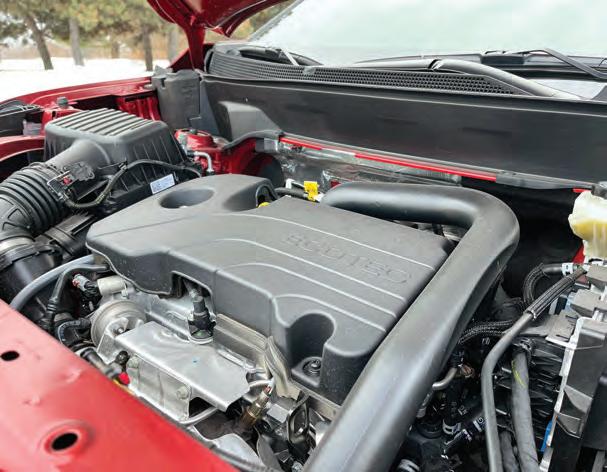
Most gas-only SUVs average in the mid 8s, while the Nissan Rogue is rated even lower at 7.6L/100km. And that’s before considering hybrids, which routinely land in the mid 6s. GM is firmly all-in on EVs, but not having a more fuel-efficient or hybrid powertrain to offer on this newin-2025 crossover feels like a miss.
Another important point for fleet managers: Chevy is moving into stalk shifters, similar to what you’d see in a Mercedes-Benz. This is fine for a one-car family, but drivers who change vehicles often might get tripped up. Pulling the right stalk forward in a driver’s personal car might activate the washer fluid, for example, but in the Equinox it shifts the car into neutral on the fly.
Depending on the nature of your fleet, this could present a serious usability issue.
Cargo space in the 2025 Chevrolet Equinox measures up at 844 litres with the rear seatbacks up and 1,798 litres with them folded. A separate compartment below the load floor helps keep fragile items protected. Below that, a 17-inch spare tire is installed. This figure is on par with some smaller competitors, but several compact SUVs offer more than 1,000 litres of cargo capacity, including the Toyota RAV4, Hyundai Tucson, Honda CR-V, and Kia Sportage. Technology excels in the 2025 Chevy Equinox. The standard 11.3-
inch LCD infotainment screen runs Google Built-in with wireless Apple CarPlay and Android Auto. An 11-inch digital instrument cluster is also standard, and an excellent wireless charging pad is available on LT and standard on the top trims. Plenty of standard safety features are included such as forward collision alert; automatic emergency braking; blind zone steering assist; rear cross-traffic alert; reverse automatic braking; rear parking sensors; a rear seat reminder; and GM’s haptic Safety Alert Seat. If fuel economy and cargo space are important factors for your fleet, you’ll be better served elsewhere. But if a gas-only compact SUV will meet your needs and higher-than-
Cargo space in the 2025 Chevrolet Equinox measures up at 844 litres with the rear seatbacks up and 1,798 litres with them folded.
average fuel economy doesn’t affect your bottom line, then the 2025 Chevy Equinox is priced fairly and provides solid value for the money. FM/SP
As Tested (2025 Chevrolet Equinox RS)
Price (including freight and PDI and dealer fees):,$48,983
Engine: 1.5-litre turbocharged I4
Power: 175hp, 203lbs-ft
Transmission: CVT (FWD); 8-speed automatic (AWD)Rated Fuel Economy (L/100km): 9.2/ 8.3/8.8 (FWD); 10.0/8.2/9.2 (AWD)
Observed Combined Fuel Economy (L/100km): 11.8
What started as a trumped-up dispute over alleged cross-border drug smuggling and illegal migration quickly turned into a threatened tariff war that then escalated into widespread calls by Canadian politicians to ban US suppliers from bidding on Canadian government contracts. However, notwithstanding Trump’s tariff threats, Canada’s federal, provincial, and local politicians should avoid playing politics with procurement since a ban on US suppliers would cause serious damage to Canadian government operations and place unnecessary risks on critical public services.
Rather than engaging in blind retaliation against Trump’s tariff threats, Canadian politicians should hold the line on government procurement and declare it a “no-fly zone” free from political interference since procurement sanctions will harm Canada more than they will harm US suppliers.
For example, on the federal front, how will our new multi-billion-dollar “made-in-Canada” naval ships ever set sail if we ban the US-made command and control systems needed to navigate those vessels?
Even if federal politicians publicly call for a ban on US suppliers, they will be forced to cave behind closed doors and grant exemptions once they realize how US supplies are critical to the delivery of many major federal government contracts. In fact, months after Trump first made his tariff threats, Canada’s federal government admitted that they were still trying to collect data to determine how many US
suppliers they rely on to support Canadian government operations. The federal government should figure this out before blindly retaliating against Trump with threats they can’t back up.
The same holds true at the provincial level. How would Canada benefit from banning US surgical equipment from Canadian hospitals? While those sanctions would hurt US suppliers, Canadians would immediately pay a far higher price through longer wait times when critical surgeries are cancelled due to supply shortages. Notwithstanding their bold public pronouncements, behind closed doors provincial politicians will be forced to cave and accept US supplies in many critical areas since doing otherwise would be irrational and self-destructive.
Turning to the municipal sector, will the Canadian mayors who back a US supplier ban be willing to put the lives of their local constituents at unnecessary risk by banning the US equipment and software required to run many local 911 systems? Of course not. Unless municipal decision-makers abandon all reason in a reckless fit of blind retaliation, critical municipal systems that rely on US suppliers will out of necessity be exempt from any US supplier ban.
Finally, will elected school board officials be prepared to leave students stranded when local school bus operators are banned from driving US-made buses or at risk in unsafe vehicles when those buses can no longer be properly maintained with spare parts from their US manufacturers? No, those school board officials will be forced to cave and add
another exemption to Canada’s fake US supplier ban.
As these obvious examples illustrate, an arbitrary ban on US suppliers is not a credible threat since it would cause serious disruptions to public sector operations in many critical areas of public service delivery across Canada and in some situations put lives at risk.
Given the unintended consequences of tinkering with the government tendering system, Canadian politicians need to stay in their lanes and keep their hands off public procurement.
Our federal politicians should focus on resolving the current tariff dispute without unnecessarily escalating the scope of the trade war by dragging government procurement into the discussion since their threats of banning US suppliers lack credibility and only serve to incite an already tense situation.
The same goes for provincial politicians. Rather than escalating the trade war by threatening US supplier bans and using the tariff dispute as cover for protectionist provincial schemes that discriminate against out-of-province Canadian suppliers, Canada’s premiers should follow through on their recent “Team Canada” commitment to remove internal trade barriers within Canada.
Finally, local politicians on municipal councils and school boards should focus on local services to their communities. They should not be inserting themselves into an international trade dispute and using that dispute as a pretext for interfering in local government contract awards.

Paul Emanuelli is the general counsel of The Procurement Office and can be reached at paul.emanuelli@ procurementoffice. com.
“Canada’s federal, provincial, and local politicians should avoid playing politics with procurement since a ban on US suppliers would cause serious damage to Canadian government operations.”
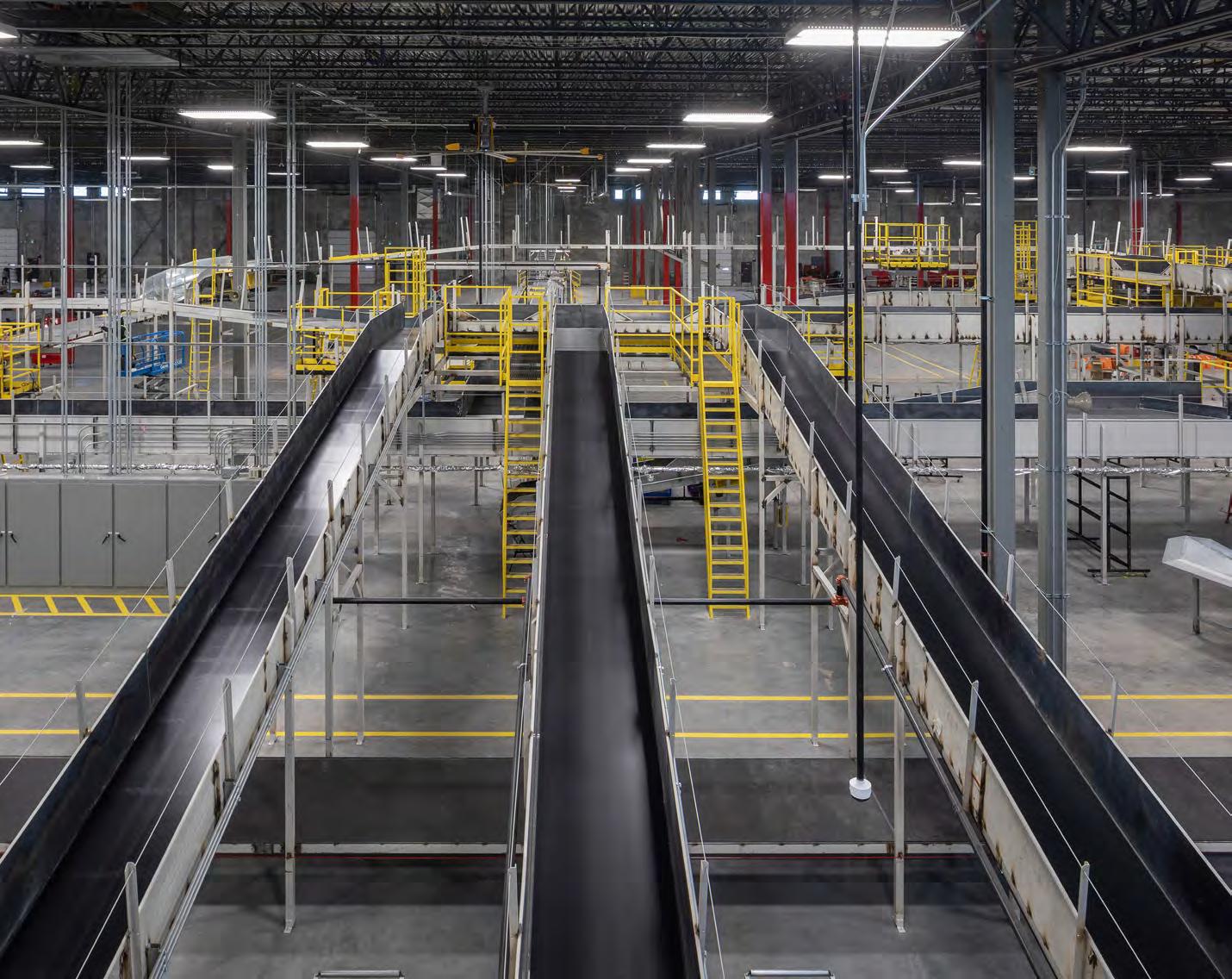
In conclusion, long after Trump backs down from his irrational tariff threats, we will still have a chronically under-resourced government procurement system.
Hopefully the politicians who were so keen on using public procurement as a fake bargaining chip during this trumped-up trade war will have the same level of interest in supporting proper procurement practices once this manufactured crisis is over. SP

Accelerated building construction from start to finish

